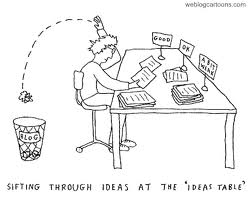
Three Steps to Building a Content Marketing Library
How to Build a Content Marketing Library and Keep it Growing
As Marcus Sheridan, founder of The Sales Lion and an entrepreneur who successfully built a million-dollar business during an economic slump once said, “great content is the best sales tool in the world.”¹ To win in sales today, you need to build a content marketing library.
Today’s marketers are well aware of the power of content marketing, yet many cite that they are either lacking in 1) sufficient content 2) time and 3) general know-how to launch effective and ongoing content-based marketing campaigns that attract and retain customers over the long-term.
I’ve found content generation to be a common challenge for virtually all the companies I work with, large and small. Truthfully, it’s easy to talk yourself into thinking it’s harder than it really is.
Many marketers overwhelm themselves by downloading loads of surveys, tips and white papers from the Internet. They also get focused on finding the right technology platform to launch their campaigns, but the fact remains, they still have a hard time actually generating enough content to keep their campaigns rolling.
It doesn’t have to be that difficult. Following are some very simple, practical tips that can work very well if you’re struggling to get started.
1. Make your content library a top priority.
Content generation is still relatively new for many companies, and is often assigned to an employee who already has a full-time job with other responsibilities. Not only are they being asked to take on additional work, but it involves writing for the Web – a professional skill, and not everyone’s favorite. Consequently, the content generation part of their work falls to the end of their project list.
A better approach is to hire a writer, either as staff or as an outsourced professional, whose primary focus is to create content ideas, gather background materials, and maintain a calendar for you. If they’re a professional business writer, they’ll have the background/training/skill set to do all of this very efficiently. In the end, this is the best and most cost-effective way to ensure that you’ll consistently have the fresh, high-quality content that your customers and prospects are looking for.
2. If you’re doing the content gathering, record interviews when speaking to your sources.
This is a great way to gradually build a library of content that can be dipped into and reused many times. It’s also very simple to do, especially with today’s conference call recording capabilities. But you’d be surprised how little it happens.
It’s a life saver. Many times, I work with entrepreneurs, executive management and industry experts whose time is quite precious. Yet these people know how important it is to share their passion and ideas with their constituents and they’ll make time if show them you’ll use it well.
I’ve found that by scheduling 30 minute interviews, we often come up with enough content to create at least four different marketing posts for the company. Of course, I always let my sources know I’m recording the call in advance and that I use the recording only to ensure that I capture their thoughts correctly. I don’t share it with anyone. I also send them a draft of the piece – in advance – so they can make any edits.
This approach is well-accepted. Many times, they appreciate the efficient use of their time and look forward to the interviews as a way to share the ideas they know are important but never seem to have the time to jot down.
3. Maintain a regular but simple schedule for content gathering.
Again, if you’re the designated content generator, try to look ahead and do some simple research for potential future topics. Jot down ideas and bookmark useful website pages. Even if you set aside a one hour twice a week for research and line up on or two interviews (recorded) per week with product managers or other company experts, you’ll have plenty of background materials for future writing projects.
Like I said, these are basic steps, but they’re very effective in building a successful content generation program. If you can get these few components of your program nailed down, you’ll be surprised at just rapidly your content library will grow.
1 Jessica Meher, “Content Challenges Facing Enterprise Marketers,” www.hubspot.com, 12/16/13.


No Comments